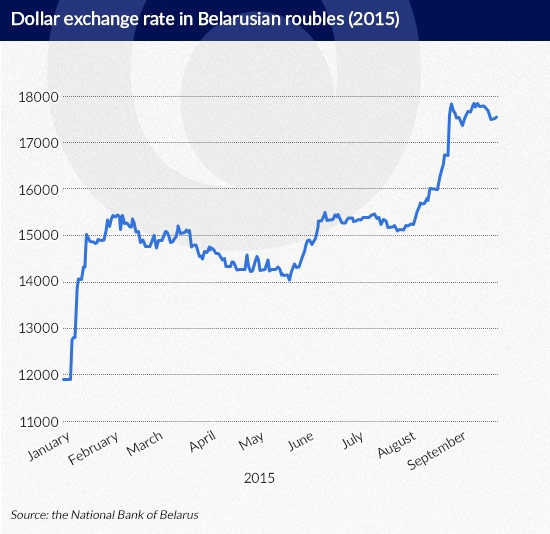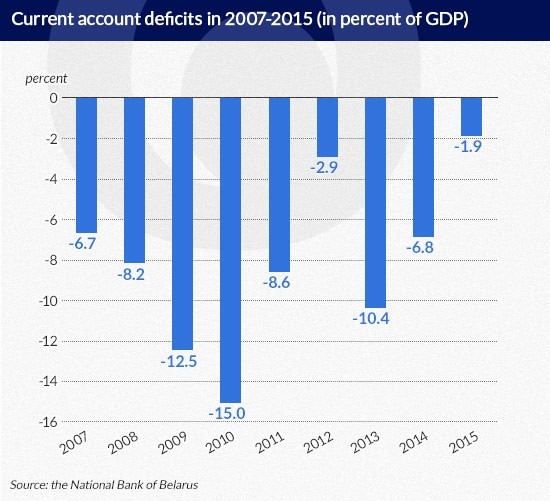
Alexander Lukashenko, President of Belarus (Kremlin.ru, CC BY)
On December 27th, 2014 r. President Lukashenka appointed the new rejuvenated government and the central bank chief, consisting of several moderate reformers with rather liberal views. In contrast to Russia, the Belarusian president took advantage of the difficult economic situation to change the government and the economic policy. In a short time the new economic team has stabilised the economy that was threw off balance due to the December’s 30 per cent devaluation of the Belarusian rouble, following similar devaluation in Russia.
Simultaneously, the government has focused on adjusting the economy to the new global conditions. The recession in Russia and low energy prices limit Belarusian exports and energy subsidies from imports of cheap Russian natural resources. Without it the quasi-socialist economy itself does not generate growth. Most likely the adverse external conditions will not improve in the coming years, and that is why Belarus has no alternatives but to carry out structural reforms.
Finally, neither the upcoming presidential elections (October 11th), nor the economic recession (-4 per cent in the first half of 2015) stops the authorities from continuing tough economic policy and gradual market reforms.
Macroeconomic stabilisation
The new Belarusian policymakers have been successfully fighting inflation. The head of the National Bank of Belarus (NBB), Paval Kalaur, immediately tightened monetary policy and introduced monetary targeting to curb the inflation. The real interest rate is already over 13 per cent. As a result, the annual consumer inflation (CPI) decreased from 17.1 per cent in January to 11.8 per cent in August 2015. The slowdown of inflation is even clearer on a monthly basis. In July and August, prices increased by 0.2 per cent per month, i.e. exactly the amount that a central bank needs to achieve the inflation target in countries like Poland (2.5 per cent annually).
(Infographics: D. Gąszczyk)
On the other hand, in accordance with the recently adopted Socio-Economic Development Programme for 2016-2020, the Belarusian government plans to decrease inflation to 5 per cent by 2020. For Belarus it would be the lowest level of inflation since 1990. So far the record low inflation reached 7 per cent in 2006.
In addition, the NBB successfully liberalized the exchange rate regime. On 1 June the central bank introduced a continuous double auction regime for three major foreign currencies (dollars, euros and Russian roubles). As a result, the exchange rate has been formed under transparent market conditions, while the regulator virtually withdrew from market interventions. Finally, the exchange rate has served as an automatic stabilizer for internal and external shocks.
Since the beginning of 2015 the dollar exchange rate in Belarusian roubles has increased by 50 per cent (from under 12.000 to almost BYR18.000 for $1). It has improved the current account. In the fourth quarter of 2014 the current account deficit was 9.5 per cent of the quarterly GDP. Yet, in the second quarter of 2015 the NBB recorded a surplus of 4.3 per cent GDP – the record high since the first quarter of 2005.
It is worth recalling that high current account deficits (mainly due to the trade deficit) in 2007-2010, in 2011 led to the worst currency crisis in Belarus in the last 20 years.
The current presidential campaign is the first during which the authorities have pursued conservative fiscal policy. The government maintains a simple principle: in the administration and state-owned enterprises (i.e. three quarters of the economy) wage growth should not exceed labour productivity growth. In January-July 2015 real salaries decreased by more than 3 per cent or 0.5 p.p. more than productivity. Thus, unit labour costs have declined since the beginning of 2015 and become an anti-inflationary factor. Moreover, in January-July 2015 the public sector surplus amounted to 3.3 per cent GDP of the same period. USD1bn saved helped servicing the public debt.
Since the 2011 currency crisis, Minsk aims at controlling the growing foreign debt. In relation to GDP the external debt fell from 58 per cent at the end of 2011 to 55 per cent on 1 July 2015. From July 2014 to July 2015 the debt decreased also in absolute terms – by around USD3bn. to less than USD38bn. This is a fundamental change in the sovereign debt policy compared to 2007-2010. Then, due to rising prices for Russian energy resources, the government stimulated economic growth by foreign loans.
Source: the National Bank of Belarus
Structural reforms are implemented
At the same time authorities are stabilizing and reforming the economy, including restructuring of state-owned industrial enterprises. Although employment in the economy in July fell by 1.5 per cent on a yearly basis, in the largest industrial factories employment decreased from a few to a dozen or so percent. For example, Minsk Automobile Plant “MAZ” and Minsk Tractor Works “MTZ”, the two biggest employers, had over 2 thousand (10 per cent) and 2.7 thousand (14 per cent) employees less in the first quarter of 2015 than in the first quarter of 2014. Even the potash factory “Belaruskali”, the third largest employer and the largest taxpayer, lied off 1.5 thousand (8 per cent) people. Finally, the top 25 industrial enterprises (all of them controlled by the state) reduced the staff by 8 per cent. The management boards continued the employment optimization in the second and third quarters of 2015.
In addition, some state-owned companies plan to accelerate privatization of redundant assets. Currently, the State Property Committee offers for sale more than one thousand properties of commercial, cultural or social feature. Auctions for some of them in the coming weeks are already assigned. However, despite the existing private sector’s demand for free commercial space, asset privatization is not carried out on a broad scale and goes on very slowly.
The authorities occasionally decide to liquidate unprofitable industrial enterprises. For example, in August 2015 a court declared bankruptcy of a hosiery factory “KIM” and ordered its liquidation. Only two years ago the company, founded in 1931, employed more than 900 people.
Nominally, Belarus is even ready for gradual privatization of medium-sized enterprises. The website of the State Property Committee declares sales by auctions or tenders of shares in 61 companies. The starting value of all the offered shares is USD0.5bn. The most interesting examples are the enterprises of the chemical industry, Mogilevchimvolokno and SvietlogorskChimvolokno, belonging to the 25 largest industrial enterprises in Belarus. On the other hand, in recent years the authorities have not rushed to privatize, demanding exaggerated prices or unrealistic investment requirements. So far, the privatization list still lacks the final decision of Lukashenka to start the privatization of medium and large enterprises.
Besides the restructuring of enterprises, the government has limited lending to the productive sector and departs from planning. According to the independent news agency BelaPAN, the resolution’s draft approving the prognostic parameters for 2016 departs from the compulsory nature of the forecasts and grants them only the indicative character. In other words, the state will not interfere with firms’ production and financial processes in order to “accomplish” forecasts.
Promised structural reforms
The Belarusian authorities announce ambitious plans for reforms. In mid-August, the government adopted a plan of radical increase in tariffs for housing services in 2016-2020. Already in 2018 Belarusians will pay full price for all housing services, with the exception of heating and hot water, which will be fully paid by 2020. Currently, households cover only one third of the housing services’ costs. It means that in five years housing bills will increase threefold.
The Belarusian officials slowly mature for changes. This concerns not only the young “reformers” who have recently come to power but also “the old guard”. For example, on 15 September 2015 the State Control Committee head, 61-year-old Leanid Anfimau, declared that “Belarus should go through a structural economic transition, although not through general privatization, but through a change of GDP structure”. Perhaps, the transition method is not well-defined, but the diagnosis of the problem remains flawless – the current economic model fails to provide development.
Moreover, in recent months the authorities, including president Lukashenka, have been mentioning the necessity for the pension reform. It is conceivable that after the presidential elections the president will decide on extension of the retirement age, which is very low at present (60 years for men and 55 years for women).
In the ongoing election campaign, Lukashenka announced a relatively liberal economic programme:
- de-monopolization of the economy,
- introduction of corporate governance in state-owned enterprises based on best international standards,
- separation of the state functions as an owner and a regulator,
- exclusion of any forms of needless interference in business activities,
- moratorium on tax increases for five years.
Lukashenko rarely keeps his words. Unlike the previous four economic election programmes, this time, however, the president does not advocate populist slogans but focuses on problems encountered by the real sector and proposes the right solutions.
International institutions’ support
The new economic policy in Belarus has been gaining recognition from international organizations. The last IMF mission in Minsk in the first half of July praised the conducted economic policy and plans for structural reforms. The IMF assured that if such a policy is continued, negotiations on granting a new IMF loan (worth around USD3bn) may be successfully finished by the year-end.
Quite unexpectedly on September 11th Belarus agreed on “the road map” for the WTO accession. The decision was made at the meeting of Foreign Minister of Belarus, Uladzimir Makiej, and the Director of the Accessions Division WTO, Chiedu Osakwe. The details have not yet been published but without further economic reforms Belarus can hardly join the WTO.
To conclude, since the beginning of 2015 the new Belarusian economic policymakers have been conducting conservative monetary policy (incl. market-oriented currency policy) and fiscal policy (incl. wage policy and sovereign debt policy). As a result, the economy regains balance, after being hit by external shocks in the second half of 2014 and the first half of 2015. In these circumstances, Minsk has taken unpopular reforms – firms’ downsizing, sale of idle assets, and liquidation of some enterprises.
These reforms, in fact, are rudimentary and slow. However, they are held in the election year, despite the recession, which gives hope that they will not be withdrawn after the presidential campaign. If external factors do not improve, perhaps at last the authorities will implement the changes that should have been implemented already in the 1990s.
The author is the Vice President at CASE Belarus and a PhD candidate at the Warsaw School of Economics (SGH), an alumnus of the London School of Economics










